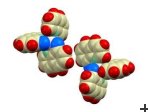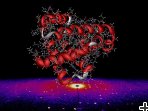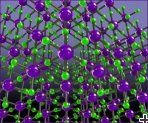Copyright 2012 neutronsources.org | All rights reserved. | Powered by FRM II | Imprint / Privacy Policy
Grand Challenges
Earth Science
Geological activity in the Earth’s upper mantle is responsible for geo-hazards such as earthquakes and volcanic eruptions. Understanding the behaviour of matter under the conditions of the Earth mantle is of prime importance. Other important fields are the investigation of continental shelf methane clathrates, which could serve as a basis for future energy supply, and the investigation of the history of the genesis of the earth.
Energy
One of the major challenges in energy management is to increase dramatically our capacity to store energy for subsequent use as electric power. Nickel-metal hydride (Ni-MH) and lithium ion materials are replacing less efficient heavy-metal batteries based on toxic cadmium and lead. The properties of these new energy storage materials depend on light-weight atoms such as hydrogen and lithium. These are difficult to see with X-rays, but they scatter neutrons strongly.
Environment
Neutron scattering is helping scientists to fight pollution and develop environmentally friendly processes that generate and release fewer contaminants into the environment. Neutron activation analysis and prompt gamma activation analysis can provide information about rare elements and serve as a way to detect contaminants. Neutron reflectometry and neutron diffraction can help define the intrinsic nature of pollutants and its relationship with the substance they are polluting.
Heritage
Neutrons are an invaluable tool to analyse precious archaeological objects: they are non-destructive and can penetrate deep into the cultural artifact or beneath the surface of paintings, to reveal structures at the microscopic scale, chemical composition or provide 3D images of the inner parts of artifacts. For heritage science purposes, whole artifacts can be placed in the neutron beam and analysed at room conditions, without sample preparation. Analysis can also be done under vacuum or other conditions, such as high or low temperature. The measurements are made in real time, which can be useful for testing conservation materials and methods.
Information technology
Due to their physical properties, neutrons are excellent tools to investigate electronic systems, magnetic data storage, spintronics, ferroelectrics, multiferroics, sensors and much more.
Medicine
Neutrons can see the elements and molecules of life – for example critical detail is provided on hydrogen bonding and hydration, which are aspects of macromolecular systems that are critical to biological function and enzymatic action. This type of information on biological structures and on the pathways associated with protein assembly (or mis-assembly) is critical to understand the molecular and cellular basis of disease. For example, neutron scattering data are providing important structural information of relevance to degenerative diseases such as Alzheimer’s disease and other conditions that are associated with the deposition of insoluble fibrils in the body. Other areas of medicine illuminated by neutron science are drug discovery and delivery, medical diagnosis, dental and bone implants, and others.
Nanotechnology
Developments in nanotechnology rely on the determination of structures over a wide range of length scales, as well as grasping how the combination of structure and dynamics leads to unique properties. Both X-rays and neutrons cover all the length scales from the Angstrom scale of the atomic structure of individual building blocks to the configuration of assembled, functional structures, making them essential tools for the elucidation of nanostructures. Neutrons, however, have some built-in advantages compared to X-rays; namely their spin, mass, and the strong scattering cross section for the hydrogen isotope deuterium.
![Brownish gray cloud (dust pollution) over the Tasman Sea just off the coast of southern Australia. True-color image taken by the Sea-viewing Wide Field-of-view Sensor [(SeaWiFS)]. Image courtesy the [SeaWiFS Project], NASA/Goddard Space Flight Center, and ORBIMAGE, on Wikimedia Commons Earth](index.php?rex_media_type=content_noresize_pop&rex_media_file=earth.jpg)





